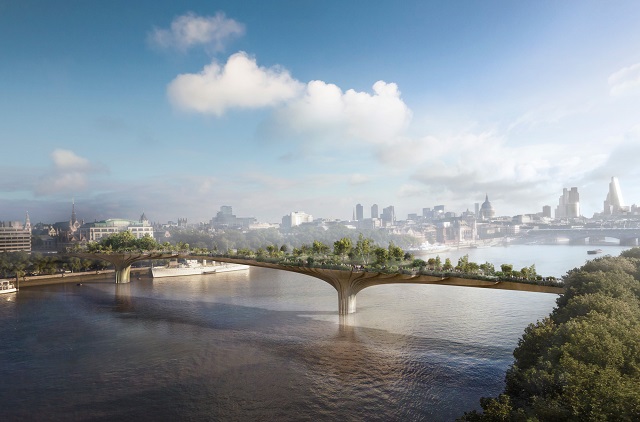London’s proposed Garden Bridge, which is to receive sixty million pounds in public subsidy, will serve “no practical purpose”, will not permit cyclists, and will have no public right of way, as taxpayers fund what appears to be an enormous, privately owned tourist attraction.
Despite London’s reputation as a city that never sleeps, the bodies providing funding for the project to build a new bridge that connects Westminster to the South Bank failed to obtain guarantees that the bridge would stay open over night, or even that there would be a public right of way over the new crossing. In reality cycling, which is London’s fastest growing means of transport, will be banned, and protesting on the private bridge will also be banned, meaning groups of eight or more will have to apply in advance to cross.
The British taxpayer will fund over one third of the cost, which at present estimates will run to £175 million. £30 million will come from central government, and another £30 million will be found from the budget for Transport for London, the cash-strapped body which runs London’s underground trains.
Questioning whether the investment in the bridge represented good value for money Andy Silvester, the campaign manager of The Taxpayers Alliance told Breitbart London: “The Garden Bridge serves no practical purpose. At a time when our public finances are stretched to the limit, this represents an unnecessary vanity.
“The money should be diverted down the river to East London where a new crossing is desperately needed – even if it might not be quite so photogenic.” The area of central London where the bridge is due to be built already features a number of crossings close by, but further east where the greatest growth in London housing over coming decades is likely to be concentrated has a shortage of crossings.
Criticising the project, London Assembly member Darren Johnson compared the bridge to the recently opened Emirates cable-car. Speaking to the Independent newspaper he said: “The cable car was meant to help commuters get across the river, but got turned into a tourist attraction by the Mayor. This looks increasingly like another of the Mayor’s high profile, tourism projects funded from tube and bus fares.”
Although the trust that will posses and manage the bridge have insisted when open it will be free to use and unticketed, it may still be closed occasionally for use as an events venue. A spokesman said: “The Trust is exploring the possibility of holding a limited number of private events on the bridge each year. Every effort would be made to ensure the bridge remains open to the general public during these events, but there may be occasions where the bridge is closed.”
The bridge’s unusual splaying form is the work of British artist Thomas Heatherwick, who is noted among architects for his unusual welded-steel design for an English seaside café. Sitting on the long, shallow beach at Littlehampton it has been described as looking “alien to its coastal surroundings”, but he is better known for the design for London’s popular new Routemaster buses.
If all goes to plan the bridge, which will go from the Victorian garden at Temple station to the modernist South-bank Centre and will open in 2018.

COMMENTS
Please let us know if you're having issues with commenting.